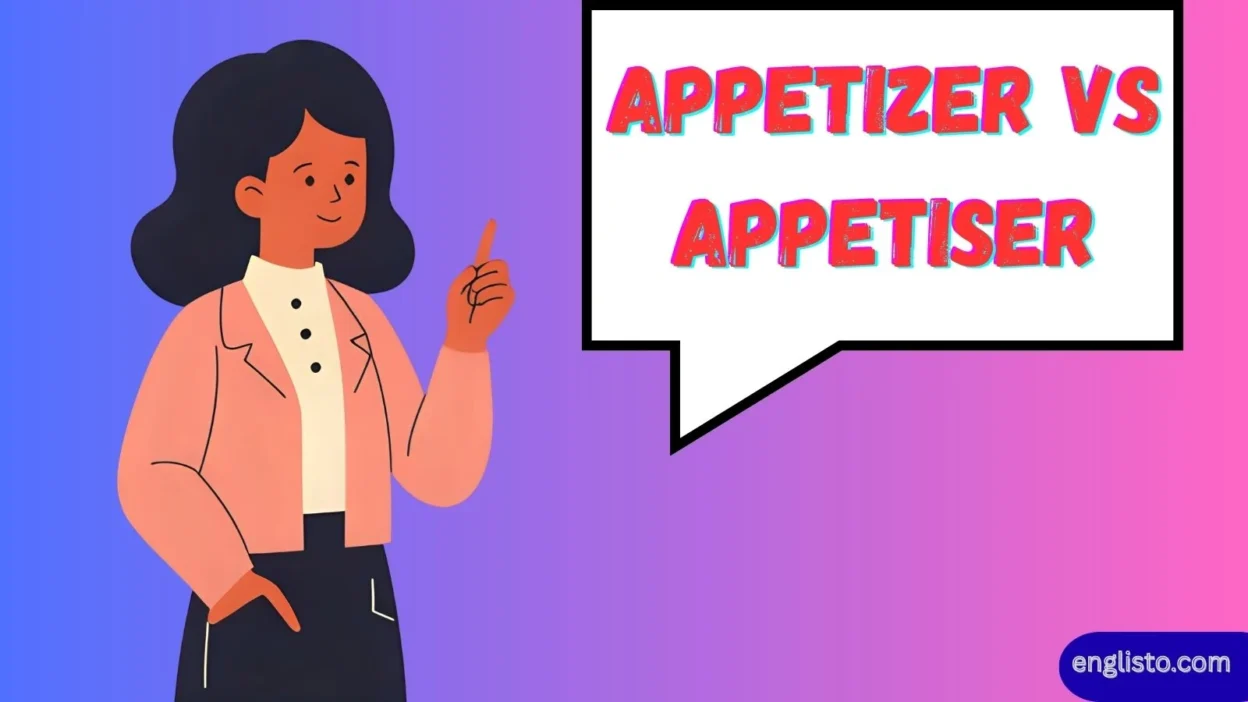Language and food have something in common: both evolve with culture, travel, and people’s habits. If you’ve ever been confused about whether to write appetizer or appetiser, you’re not alone. This tiny difference in spelling often sparks bigger conversations about American English vs British English, regional preferences, and even how menus are written across the globe. Appetizer vs Appetiser.
But beyond spelling, the word itself is tied to culture, hospitality, and centuries of dining traditions. In this article, we’ll unpack the meaning, history, types, and usage of the word—while keeping things flavorful with examples, comparisons, and even a few delicious side notes.
What Does “Appetizer” (or “Appetiser”) Mean?
At its core, both appetizer and appetiser refer to a small dish served before the main course. Its purpose is simple: to stimulate the appetite and prepare diners for the meal ahead.
Think of them as little teasers, often paired with drinks, bringing guests together before the star of the meal arrives.
- Noun type: Countable
- Common synonyms: starter, hors d’oeuvre, finger food, antipasto
Here’s a quick comparison:
| Term | Region Used Most | Definition |
| Appetizer | United States, Canada (North America) | A small dish served before the main meal. Preferred spelling in American English. |
| Appetiser | United Kingdom, Australia, New Zealand, South Africa | Same meaning, just the British English spelling. |
| Starter | Mostly UK | A broader word for the first course, which could include soups and salads. |
👉 Key takeaway: Both spellings are correct, depending on where you are.
Read More: It’s All Relative: Meaning, Usage, and Why Context Matters
The Spelling Divide: “Appetizer” vs “Appetiser”
English has a long history of diverging spellings. Think color vs colour, organize vs organise, or theater vs theatre. The same rule applies here:
- Appetizer (with a Z): American English prefers “-ize” endings, influenced by Webster’s dictionary in the early 1800s.
- Appetiser (with an S): British English holds onto “-ise,” a spelling closer to older French and Latin roots.
Examples in sentences:
- American: “The restaurant serves a wide range of appetizers, from sliders to shrimp cocktails.”
- British: “The pub offers traditional appetisers like Scotch eggs and cheese platters.”
Fun fact: The first recorded use of “appetizer” in English dates back to the 1820s.
What Are Appetizers?
Appetizers aren’t just about filling a plate; they’re about setting the tone of a meal. They act as an edible handshake—welcoming, light, and often creative.
Typical features of appetizers:
- Small portions (2–4 bites)
- Can be hot or cold
- Usually savory but can also be sweet
- Designed to whet, not satisfy the appetite
Common occasions where appetizers shine:
- Parties & weddings – bite-sized hors d’oeuvres with champagne
- Holiday celebrations – think cheese boards, dips, or deviled eggs
- Restaurants – starters to complement the menu
- Casual gatherings – chips and salsa at a barbecue
Types of Finger Foods (The Appetizer Family)
Appetizers come in all shapes and flavors. From light salads to indulgent fried bites, the variety is endless.
Here’s a table breaking down popular types of finger foods:
| Category | Examples | Features |
| Canapés | Crackers with cheese, smoked salmon on toast | Bite-sized, elegant, often topped with spreads |
| Crudités | Carrot sticks, celery, cucumbers, radishes | Raw vegetables served with dips |
| Dips & Chips | Guacamole, hummus, spinach dip, tortilla chips | Shareable, creamy or chunky, great for socializing |
| Seafood | Shrimp cocktail, oysters, calamari | Fresh, often paired with sauces |
| Salads | Caesar salad, beetroot salad, cucumber salad | Light, fresh, sometimes pickled |
| Savory Bites | Meatballs, sliders, mini quiches | Heartier, often hot and seasoned |
| Sweet Starters | Fruit skewers, candied nuts, mini tarts | Less common, but perfect for brunches |
👉 These can be as simple as potato chips or as sophisticated as lobster canapés.
A Bite of History: Where Did Appetizers Come From?
The story of appetizers is as rich as the food itself.
- Ancient Greece (3rd century B.C.): Athenians enjoyed small nibbles like garlic, cockles, and sea urchins before meals.
- Romans: Loved their aperitifs (drinks before meals), paired with olives, nuts, and small bites.
- Medieval Europe: Buffets of cured meats, cheeses, and breads were common, though sometimes criticized for leaving people too hungry.
- 19th Century England & America: The idea of a structured multi-course meal, with appetizers leading the way, became fashionable.
- Modern day: From sushi rolls to tapas, appetizers have gone global, adapting to local tastes and traditions.
“Food is culture on a plate. Appetizers tell us not just what people eat, but how they welcome others to the table.”
What’s the Difference Between an Appetizer and Hors d’Oeuvre?
The words often overlap, but there are subtle differences:
| Feature | Appetizer | Hors d’Oeuvre |
| Origin | English | French (“outside the meal”) |
| When served | At the table, before the main course | During cocktail hour, while mingling |
| Portion size | Larger (3–4 bites) | Smaller (1–2 bites) |
| Setting | Seated dining | Standing, passed around |
| Examples | Soups, salads, sliders | Canapés, stuffed mushrooms, mini pastries |
👉 In short: All hors d’oeuvres are appetizers, but not all appetizers are hors d’oeuvres.
Starters vs Appetizers: Are They the Same?
In the UK, starter is often used instead of appetizer. But there are subtle differences:
- Starter: Can include soups, salads, and lighter bites.
- Appetizer: More associated with finger foods and savory snacks.
Examples:
- UK menu: “Soup of the day – Starter”
- US menu: “Buffalo wings – Appetizer”
Both, however, serve the same purpose: to kick off the meal.
Real-Life Usage Examples
To see the spelling differences in action:
- American newspaper (U.S. News): “The restaurant’s appetizers range from nachos to fried calamari.”
- British publication (The Guardian): “Guests were served appetisers including olives, pâté, and fresh bread.”
👉 Notice how both articles use the same word, spelled differently, but understood universally.
Common Spelling Mistakes and Tech Confusion
With autocorrect, online ordering, and global menus, spelling confusion is common.
- Mobile keyboards may default to “appetizer” in U.S. English settings.
- Spellcheck in UK-based systems will suggest “appetiser.”
- On international menus, restaurants sometimes mix spellings—leading to inconsistency.
Tip: If you’re writing for a U.S. audience, go with appetizer. If you’re writing for a UK or Commonwealth audience, choose appetiser.
Appetizers in Today’s Food Culture
Appetizers have become more than just “small plates.” They’re a way to:
- Socialize: Sharing nachos or dips makes gatherings more interactive.
- Show creativity: Chefs experiment with bold flavors in appetizer menus.
- Offer variety: Diners can try multiple dishes without committing to one main course.
Some of today’s popular appetizers include:
- Buffalo wings
- Bruschetta
- Deviled eggs
- Spinach artichoke dip
- Shrimp cocktail
- Sliders
- Gourmet cheese boards
👉 Notice how many of these are American classics that have gained global acceptance.
Appetizer vs Appetiser: Final Clarification
To wrap it up:
| Spelling | Region | Example |
| Appetizer | American English | “The appetizers were delicious at the holiday dinner.” |
| Appetiser | British English & Commonwealth | “Traditional pub appetisers included Scotch eggs and pickled onions.” |
Both are right. The choice depends on where you are and who you’re writing for.
FAQs About “Appetizer vs Appetiser”
Q1: Which spelling is correct—appetizer or appetiser?
Both are correct. “Appetizer” is American English, while “appetiser” is British English.
Q2: Is a starter the same as an appetizer?
Yes, but “starter” is more common in the UK and may include soups and salads.
Q3: Are hors d’oeuvres just appetizers?
Not exactly. Hors d’oeuvres are a type of appetizer, usually smaller and served during social mingling.
Q4: When did the word appetizer first appear?
The earliest recorded use was in the 1820s, in American English.
Q5: What are some easy homemade appetizers?
Bruschetta, stuffed mushrooms, potato wedges, deviled eggs, and seasonal fruit skewers.
Conclusion
Whether you write it with a Z or an S, the meaning doesn’t change—appetizer and appetiser are two flavors of the same word. They both describe the delightful bites that start a meal, bring people together, and set the stage for what’s to come.
So next time you’re hosting a dinner, planning a menu, or proofreading a restaurant flyer, remember: the only real difference is spelling, not taste. And whichever way you spell it, your guests will still be hungry for more.



